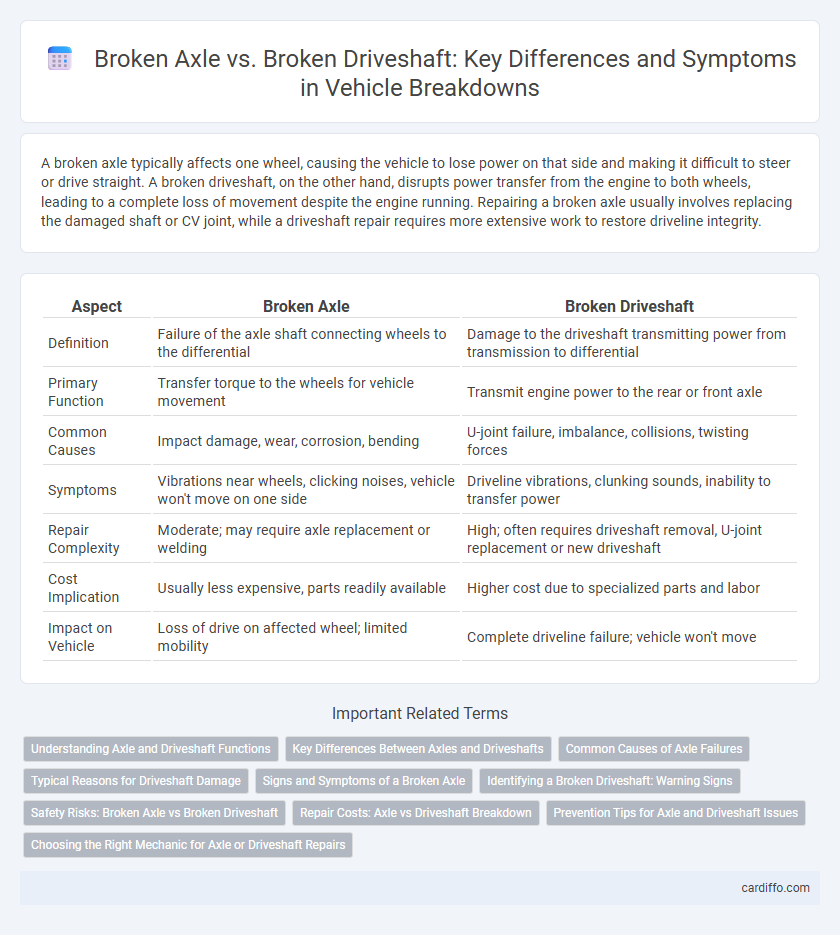A broken axle typically affects one wheel, causing the vehicle to lose power on that side and making it difficult to steer or drive straight. A broken driveshaft, on the other hand, disrupts power transfer from the engine to both wheels, leading to a complete loss of movement despite the engine running. Repairing a broken axle usually involves replacing the damaged shaft or CV joint, while a driveshaft repair requires more extensive work to restore driveline integrity.
Table of Comparison
| Aspect | Broken Axle | Broken Driveshaft |
|---|---|---|
| Definition | Failure of the axle shaft connecting wheels to the differential | Damage to the driveshaft transmitting power from transmission to differential |
| Primary Function | Transfer torque to the wheels for vehicle movement | Transmit engine power to the rear or front axle |
| Common Causes | Impact damage, wear, corrosion, bending | U-joint failure, imbalance, collisions, twisting forces |
| Symptoms | Vibrations near wheels, clicking noises, vehicle won't move on one side | Driveline vibrations, clunking sounds, inability to transfer power |
| Repair Complexity | Moderate; may require axle replacement or welding | High; often requires driveshaft removal, U-joint replacement or new driveshaft |
| Cost Implication | Usually less expensive, parts readily available | Higher cost due to specialized parts and labor |
| Impact on Vehicle | Loss of drive on affected wheel; limited mobility | Complete driveline failure; vehicle won't move |
Understanding Axle and Driveshaft Functions
An axle transmits power from the differential to the wheels, supporting vehicle weight and enabling wheel rotation, while a driveshaft transfers torque from the transmission to the differential, allowing power delivery to the axles. A broken axle results in loss of wheel movement or steering control due to direct wheel connection failure, whereas a broken driveshaft disrupts torque transfer between transmission and axle, causing drivetrain immobility. Understanding these functional differences clarifies the distinct impacts and repairs required for axle versus driveshaft breakdowns.
Key Differences Between Axles and Driveshafts
A broken axle differs from a broken driveshaft primarily in location and function, where the axle connects the wheels to the vehicle and transmits power locally, while the driveshaft transfers torque from the transmission to the axle. Axle damage often results in wheel misalignment, uneven tire wear, and handling issues, whereas driveshaft failure typically causes vibrations, clunking noises, and loss of power transmission. Understanding these key differences helps diagnose broken axle versus broken driveshaft problems effectively, minimizing costly repairs and ensuring vehicle safety.
Common Causes of Axle Failures
Axle failures often result from severe impacts, worn-out bearings, and poor lubrication, causing metal fatigue and eventual breakage. Broken axles typically occur due to hitting potholes, curbs, or off-road obstacles that stress the axle shaft beyond its limits. In contrast, driveshaft issues usually stem from vibration problems, U-joint failure, and misalignment rather than direct impact.
Typical Reasons for Driveshaft Damage
Driveshaft damage often results from excessive torque during off-road driving, abrupt impacts, or worn-out universal joints causing imbalance and vibration. Corrosion and lack of lubrication can accelerate wear, leading to cracks or complete shaft failure. Unlike broken axles, driveshaft issues frequently stem from drivetrain misalignment or faulty center support bearings.
Signs and Symptoms of a Broken Axle
A broken axle typically causes noticeable vibrations, loud clunking noises when turning, and uneven tire wear, indicating compromised wheel rotation. Drivers may experience difficulty in steering and a pronounced pulling to one side, especially during acceleration or braking. Visual inspection often reveals a visibly bent or damaged axle shaft, fluid leaks from axle seals, or excessive play in the wheel hub assembly.
Identifying a Broken Driveshaft: Warning Signs
A broken driveshaft often causes noticeable vibrations, clunking noises during acceleration, and difficulty turning the vehicle. Symptoms include a loss of power to the wheels, uneven tire wear, and visible damage to the driveshaft components. Early detection of these warning signs helps prevent further damage to the drivetrain and costly repairs.
Safety Risks: Broken Axle vs Broken Driveshaft
A broken axle causes immediate loss of vehicle control and can lead to dangerous wheel detachment, posing severe safety risks. A broken driveshaft typically results in loss of power transmission to the wheels, causing sudden immobilization but generally less risk of wheel detachment. Both failures require prompt attention to prevent accidents, with axle damage considered more hazardous due to potential steering and stability issues.
Repair Costs: Axle vs Driveshaft Breakdown
Repair costs for a broken axle typically range from $300 to $1,000, depending on the vehicle make and model, while a broken driveshaft repair can cost between $500 and $1,200 due to its complexity and labor intensity. Axle replacements often require part and labor but fewer hours compared to driveshaft repairs, which may involve additional balancing and alignment. Insurance coverage and the severity of the damage significantly influence the final repair expenses for both components.
Prevention Tips for Axle and Driveshaft Issues
Regularly inspect axle and driveshaft components for signs of wear, such as cracks, corrosion, or damaged boots, to prevent sudden breakdowns. Maintain proper lubrication levels in differential and transmission systems to reduce friction and extend the lifespan of axles and driveshafts. Avoid overloading the vehicle and driving on rough terrain to minimize stress on these critical drivetrain parts.
Choosing the Right Mechanic for Axle or Driveshaft Repairs
Choosing the right mechanic for axle or driveshaft repairs requires expertise in diagnosing the specific failure, whether it's a broken axle or driveshaft. Mechanics specializing in driveline and suspension systems offer precise repairs, reducing the risk of recurring issues. Ensure the chosen auto shop utilizes OEM parts and provides warranty coverage to guarantee lasting reliability and safety.
Broken axle vs broken driveshaft Infographic

 cardiffo.com
cardiffo.com